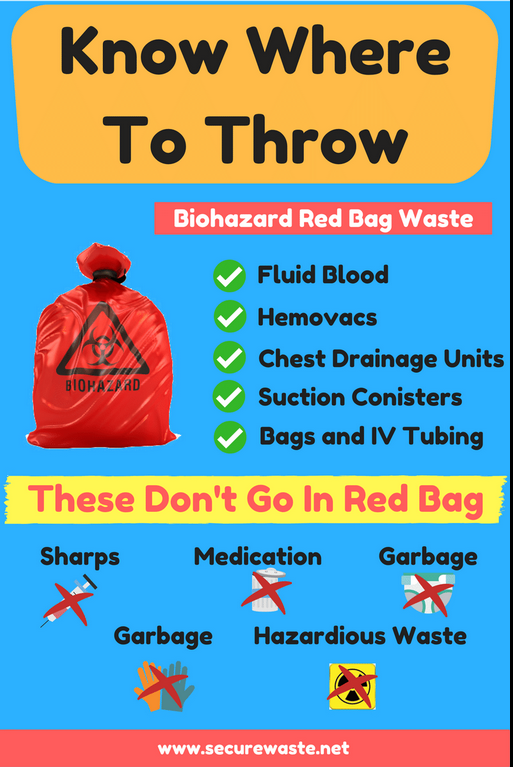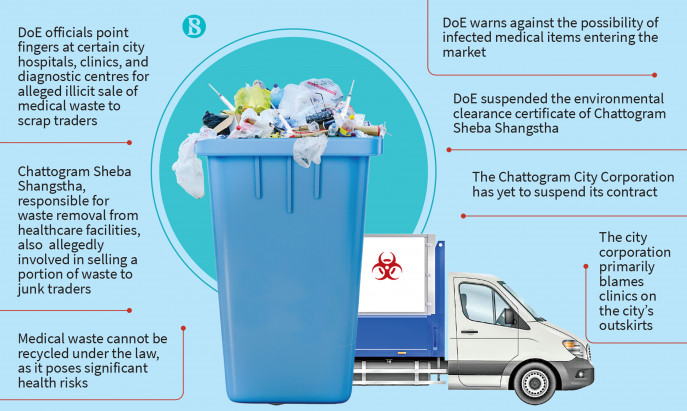Medical Waste Removal Quality: Elevating Safety And Security Requirements in Your Center
Medical Waste Removal Quality: Elevating Safety And Security Requirements in Your Center
Blog Article
Stay Ahead of Laws: Professional Suggestions on Medical Waste Disposal
In a globe where the medical care industry is constantly advancing, it is necessary for medical centers to stay in advance of regulations when it comes to the proper disposal of clinical waste. From comprehending the different classifications of medical waste to carrying out the ideal collection and segregation techniques, this conversation will provide workable tips and important understandings to assist centers stay in advance of policies in the ever-changing landscape of clinical waste disposal.
Comprehending Clinical Waste Categories
Understanding clinical waste categories is essential for appropriate disposal and management in health care centers. Clinical waste describes any type of waste generated by medical care activities that might position a hazard to public health or the setting. It is important to classify medical waste precisely to guarantee its safe handling, disposal, transport, and treatment.
There are a number of groups of medical waste that health care centers require to be accustomed to. The most typical groups include contagious waste, pathological waste, sharps waste, pharmaceutical waste, and chemical waste. Each group has details guidelines and policies for its appropriate monitoring and disposal.
Pathological waste refers to human tissues, organs, or body parts that require unique handling and disposal. Drug waste consists of ended, unused, or contaminated drugs that need mindful handling and disposal.
Remaining Up-To-Date With Regulatory Adjustments
Staying current with governing adjustments is essential for healthcare centers to make certain conformity and appropriate administration of medical garbage disposal. medical waste removal services. With policies continuously evolving, it is crucial for medical care facilities to stay current to prevent penalties, penalties, and prospective harm to the setting and public wellness
To stay in advance of regulative changes, medical care facilities should develop a system for tracking and tracking updates. This can be done by registering for regulative newsletters, participating in workshops and conferences, and proactively participating in sector associations. In addition, centers ought to designate a staff participant or group responsible for remaining informed and sharing info to pertinent stakeholders.
Routine interaction with regulatory firms is also crucial. Healthcare facilities need to establish connections with local, state, and federal firms to ensure they recognize any modifications in regulations that might impact their waste administration methods. This can be done with normal meetings, involvement in public remark durations, and proactive interaction with governing agencies.
Furthermore, medical care facilities need to think about partnering with waste management firms that focus on medical garbage disposal (medical waste disposal services with WasteX). These firms are usually fluent in the newest guidelines and can give guidance and support to guarantee compliance
Carrying Out Correct Collection and Partition Approaches
To effectively handle clinical garbage disposal, health care centers need to develop appropriate collection and partition techniques in conformity with regulative guidelines. Carrying out these techniques makes sure the risk-free handling and disposal of potentially dangerous materials, protects the environment, and minimizes the risk of infections and injuries to health care workers and the general public.
Appropriate collection and partition approaches entail the use of assigned containers and classifying systems. Healthcare facilities ought to supply plainly labeled containers for various kinds of medical waste, such as medical waste disposal services with WasteX sharps, infectious waste, pharmaceutical waste, and non-hazardous waste. These containers must be color-coded and plainly significant to prevent complication and promote easy identification.
Additionally, medical care facilities need to educate their team on the appropriate procedures for gathering and setting apart clinical waste. This consists of enlightening them on the various kinds of waste, the proper containers to utilize, and the relevance of complying with guidelines and guidelines. Routine training sessions and refresher training courses must be conducted to make certain that personnel stay up-to-date on finest practices.
Moreover, health care centers should develop a system for routine collection and disposal of clinical waste. This might entail partnering with accredited waste monitoring companies that concentrate on medical garbage disposal. These firms will ensure that the accumulated waste is moved and gotten rid of in conformity with medical waste disposal services with WasteX regulative needs.
Selecting the Right Disposal Approaches

Incineration is just one of the most effective and typical methods for throwing away particular sorts of clinical waste, such as pathological waste and sharps. It entails the regulated burning of waste at heats, lowering it to ash. Incineration can release dangerous toxins into the air and add to air contamination.

Various other disposal approaches consist of chemical treatment, microwave treatment, and landfilling. Chemical treatment involves the usage of chemicals to neutralize the waste and decontaminate. Microwave therapy uses microwave energy to heat and disinfect the waste. Landfilling involves burying the waste in an assigned land fill location (medical waste disposal services with WasteX). Nevertheless, landfilling ought to be the last hope as a result of the prospective threat of contamination to dirt and groundwater.
Making Sure Compliance With Paperwork and Training
After very carefully taking into consideration the ideal disposal approaches for clinical waste, medical care centers need to make sure conformity with guidelines and lessen environmental effect by executing effective documentation and training procedures. This step is crucial in maintaining More about the author a lasting and secure environment for both health care workers and the general public.

Healthcare workers that deal with medical waste needs to obtain appropriate training on waste partition, taking care of, and disposal procedures. By offering detailed training, medical care facilities can equip their personnel to make informed decisions and reduce the risk of improper waste disposal.
Conclusion
Finally, staying ahead of policies in medical waste disposal is essential for healthcare centers. medical waste removal service. Understanding the various groups of medical waste, remaining upgraded with regulative changes, implementing correct collection and partition methods, picking the ideal disposal techniques, and guaranteeing conformity with documentation and training are all essential actions. By complying with these guidelines, medical care organizations can properly get rid of and take care of of medical waste in a safe and responsible way
From understanding the different groups of clinical waste to implementing the appropriate collection and partition techniques, this discussion will supply beneficial understandings and workable pointers to aid facilities stay in advance of laws in the ever-changing landscape of clinical waste disposal. - medical waste disposal services with WasteX
The most common groups consist of contagious waste, pathological waste, sharps waste, pharmaceutical waste, and chemical waste. Healthcare facilities should give plainly classified containers for various kinds of clinical waste, such as sharps, infectious waste, pharmaceutical waste, and non-hazardous waste. Healthcare facilities must develop a detailed system to videotape and track all facets of medical waste disposal, consisting of types of waste created, quantities, and disposal techniques made use of. Healthcare workers that deal with clinical waste ought to get appropriate training on waste segregation, dealing with, and disposal treatments.
Report this page